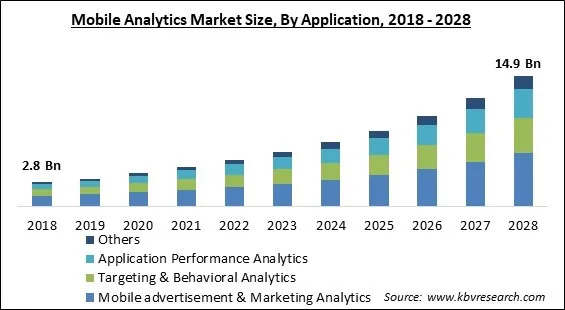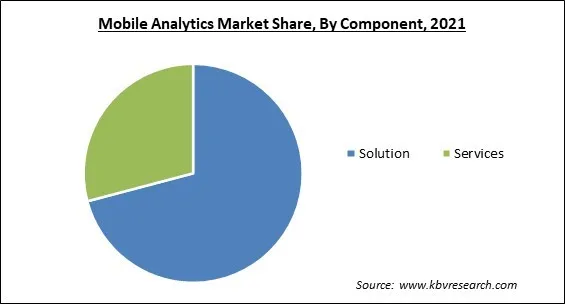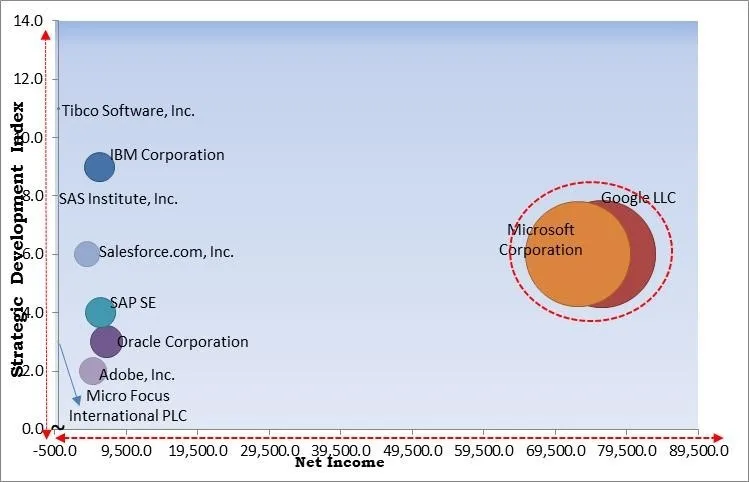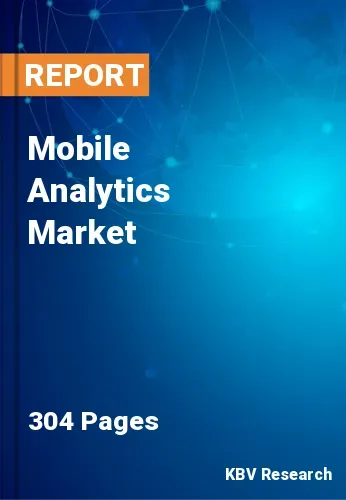The Global Mobile Analytics Market size is expected to reach $14.9 billion by 2028, rising at a market growth of 19.0% CAGR during the forecast period.
Analytics is gathering and analyzing user data to understand better user behavior and the functionality of a website or service. Mobile platforms and properties, like mobile sites and mobile applications, generate data, which is measured and analyzed in mobile analytics. Mobile analytics monitors user interaction with the app in addition to app-specific information, including installs, launches, taps, events, versions, screens, user retention, funnel analytics, flows, and more.

Mobile analytics also gathers and assesses equivalent user metrics to web analytics, like the number of people using the app, their nation of origin, the type of device they are using, and the operating system version they are using. Global demand for mobile analytics has increased due to the market smartphone penetration and the need for new and valuable insight into consumer preferences.
Furthermore, the market for mobile analytics has also grown due to the rise in mobile advertising and the introduction of data analytics and big data. On the contrary hand, more chances are anticipated to arise throughout the anticipated period as more businesses enter the market and offer cutting-edge solutions.
Organizations are very concerned while analyzing their sales funnels, customer profiles, crash rates, demographics, open app rates, customer retention, or any other data that is relevant to their business, such as sliding away users, time spent on the app, or most common paths to an in-app purchase.
To be more specific, in case a company discovers that 75% of its users leave the shipment screen of their sales to funnel, there probably is a design, user interface (UI), or user experience (UX) issue with that screen, or there is a technical issue preventing users from finishing the transaction.
A few of key factors propelling the market include the rise in the number of digital transactions, the proliferation of smart devices, the widespread adoption of IoT technology, the ongoing rollout of 5G networks, the adoption of Industry 4.0, and the potential for large volumes of data to be produced by the FinTech, GamingTech, EduTech, HealthTech, ACES mobility, and media & entertainment sectors, among other industries and industry verticals. All of these elements have benefited the market's expansion. By eliminating the reliance on employee availability during the epidemic, mobile analytics and automation incidentally supported remote working and ensured corporate resilience.
Since the 2007 launch of the iPhone, mobile activity has significantly increased. Every year, there has been a double-digit increase in mobile device usage. Google announced mobile-first indexing at the beginning of 2020, changing its algorithm for indexing and ranking all online content to be mobile-first. Mobile analytics is becoming more widely used as a result of rising smartphone usage and the creation of several mobile-based applications. These elements all help the market for mobile analytics to expand.
Real-time advertising, which refers to the overall category of graphics-based web advertising, is a performance-based type of display advertising. The created marketing materials are graphically shown online. RTA utilizes real-time bidding (RTB), a technique that enables the auctioning of online advertising space in milliseconds. Artificial intelligence (AI) marketing automates marketing choices and activities based on data gathering and analysis.
While mobile applications (apps) are being used more and more frequently by online users for their daily tasks and requirements, processing personal data through these tools poses serious security and privacy threats to consumers. These risks are primarily caused by the variety of data and sensors stored in mobile devices, the use of various identifiers and increased possibility of user monitoring, the complex mobile app ecosystem, and the app developers' limitations, as well as the extensive use of third-party software and services.
Based on the Component, the Mobile Analytics Market is divided into Solutions and Services. In 2021, the solution segment led the market for mobile analytics, and it is anticipated that it will continue to do so during the anticipated time frame. This is due to the rising demand for BI (Business Intelligence) tools and advanced analytics. Additionally, a major factor in the market expansion for mobile analytics solutions is the increased demand for real-time business information to make quicker business choices.

Based on application, the Mobile Analytics Market is categorized into Mobile Advertising and Marketing Analytics, Targeting and Behavioral Analytics, Application Performance Analytics, and Others. The targeting and behavioral analytics market garnered the significant revenue share in 2021. The main drivers of the growth of the targeting and behavioral analytics market in mobile analytics are an increase in the usage of cloud-based targeting and behavior analytic solutions and an improvement in behavior analytics security measures. The growth of in-app behavior analytics is also fueled by the rise in demand for real-time data.
Based on end-user, the Mobile Analytics market is categorized into BFSI, Retail & E-commerce, Healthcare, Government, Travel & Hospitality, IT & Telecom, Media & Entertainment, and Others. During the projected period, the healthcare segment is anticipated to develop at the fastest rate. Mobile engagement technology is constantly improving as smartphone usage soars, and consumer expectations for rapid access to goods and services rise. In order to fully profit from the numerous capabilities that mobile analytics in the healthcare sector offers, healthcare companies are heavily utilizing mobility solutions for improved patient engagement.
Based on Organization size, the Mobile Analytics Market is divided into Large Enterprises and SMEs. In 2021, the large enterprises segment led the growth of the mobile analytics market, and it is anticipated that it will continue to do so in the years to come. The main forces behind the market's expansion are the rising use of smartphones and the internet. Additionally, the growth of mobile advertising and the appearance of innovative digital technologies such as IoT and data analytics are the main drivers of mobile analytics.
| Report Attribute | Details |
|---|---|
| Market size value in 2021 | USD 4.5 Billion |
| Market size forecast in 2028 | USD 14.9 Billion |
| Base Year | 2021 |
| Historical Period | 2018 to 2020 |
| Forecast Period | 2022 to 2028 |
| Revenue Growth Rate | CAGR of 19% from 2022 to 2028 |
| Number of Pages | 304 |
| Number of Tables | 483 |
| Report coverage | Market Trends, Revenue Estimation and Forecast, Segmentation Analysis, Regional and Country Breakdown, Competitive Landscape, Companies Strategic Developments, Company Profiling |
| Segments covered | Component, Application, Organization Size, End-use, Region |
| Country scope | US, Canada, Mexico, Germany, UK, France, Russia, Spain, Italy, China, Japan, India, South Korea, Singapore, Malaysia, Brazil, Argentina, UAE, Saudi Arabia, South Africa, Nigeria |
| Growth Drivers |
|
| Restraints |
|
Based on geography, the Mobile Analytics Market is categorized into North America, Europe, Asia Pacific, and LAMEA. North America currently dominated the mobile analytics market in 2021 and is anticipated to maintain doing so over the course of the projection period due to the significant acceptance rate of mobile analytics solutions because of their affordability and scalability. Additionally, to improve work processes, North American retail companies are investing in cutting-edge technologies.
Free Valuable Insights: Global Mobile Analytics Market size to reach USD 14.9 Billion by 2028

The major strategies followed by the market participants are Acquisition. Based on the Analysis presented in the Cardinal matrix; Google LLC and Microsoft Corporation. are the forerunners in the Mobile Analytics Market. Companies such as IBM Corporation, Oracle Corporation, SAP SE are some of the key innovators in Mobile Analytics Market.
The market research report covers the analysis of key stake holders of the market. Key companies profiled in the report include Adobe, Inc., Google LLC, IBM Corporation, Micro Focus International PLC, Microsoft Corporation, SAS Institute, Inc., Oracle Corporation, SAP SE, Salesforce.com, Inc., and Tibco Software, Inc. (Vista Equity Partners)
By Component
By Application
By Organization Size
By End-use
By Geography


The global Mobile Analytics Market size is expected to reach $14.9 billion by 2028.
An Increase In Mobile Users are driving the market in coming years, however, Concerns Pertaining To Security Breaches restraints the growth of the market.
Adobe, Inc., Google LLC, IBM Corporation, Micro Focus International PLC, Microsoft Corporation, SAS Institute, Inc., Oracle Corporation, SAP SE, Salesforce.com, Inc., and Tibco Software, Inc. (Vista Equity Partners)
The expected CAGR of the Mobile Analytics Market is 19.0% from 2022 to 2028.
The Mobile advertisement & Marketing Analytics segment acquired maximum revenue share in the Global Mobile Analytics Market by Application in 2021 thereby, achieving a market value of $6 billion by 2028.
The North America market dominated the Global Mobile Analytics Market by Region in 2021, and would continue to be a dominant market till 2028; thereby, achieving a market value of $5.2 billion by 2028.
Our team of dedicated experts can provide you with attractive expansion opportunities for your business.

